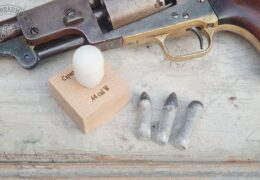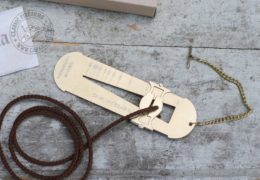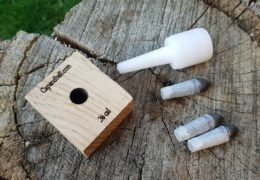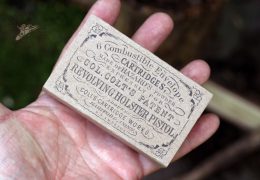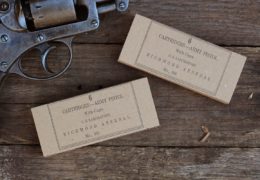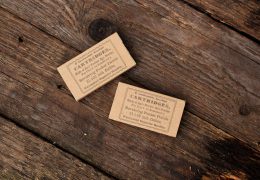How to handle your muzzleloader revolver – part 3

Dealing with residues
As with every muzzleloading firearm, the matter of fouling is very important. It is obvious, that without proper lubrication, the amount of unwanted material accumulates in the barrel, causing accuracy problems and makes the next cleaning session a nightmare. The greasing put on top of the charge seals the the chamber (so you don’t have to worry about chain fire) and softens the fouling in the barrel (so the next projectile will wipe out the most of it). Also, a good lubricant seals the gap between the bullet and the rifling.
Open-top or top-strap frame?
Residues does not only affect the barrel. A noticable amount of gas escapes the system at the gap between the chamber and the forcing cone, so fouling will be on the axis and the rotating mechanism. In an extreme scenario, forcing the hammer to rotate the cylinder can damage the rotating assembly. If it jams, the proper procidure is to pull the hammer gently with one hand, and helping the cylinder to rotate with the other (avoid to put your fingers in front of the chamers).
Revolver designers tried to solve this problem in many ways. In Colt’s revolvers, one can notice a thread cut in the axis, into which the fouling could accumulate without jamming the action. The Rogers&Spencer revolver’s axis is protected by the cylinder, with a ring-shaped surface above the cylinder plain. Remingtons are the most vulnerable to this issue: the axis is thin and has no protection against fouling.
It is recommended to treat the axis of your revolver with thermostable grease. Colt’s advantage is that you can adjust the gap with the wedge. The thinner is the gap, the less residue will be on the moving parts.
Jamming can be caused by parts of the percussion caps. The used cap stays on the nipple, if the main spring is strong enough and the vent hole of the nipple is small. On open-top revovlers – almost all Colts – a noticable space is open at the base of the hammer when it is pulled back, and the frame slides the percussion cap parts into it, causing the revolver to jam.
Back in the days, soldiers pulled the hammer back while pointing upwards with the barrel. This can’t be done on shooting ranges due to safety regulations. You can also try tilting the revolver 90 degrees sideways, so the caps will not fall into the action. But the best way to solve this problem is placing a little bar into frame, just behid the nipple, which will hold the cap in place during the shot. Revolvers with a top-strap frame (Remington, Rogers & Spencer, Spiller & Burr, Ruger Old Army, Starr, muzzleloader Cattleman) have a clear advantage. The frame surrounds the cylinder and the hammer strikes in through a little hole, cut into the frame. This prevents the cap particles falling into the action – the problem, which all Colts suffer of.
The accuracy is very much determined by the allignment of the chambers with the barrel and the forcing cone. This can be checked with a light source, pinted into the barrel. This should be done when the hammer is full cocked. If we see a shallow C-form (the “crescent moon”) at the top of the cylinder, that shows misallignment. If the cylinder can be rotated slightly and that shows good allignment, do not worry: the forcing cone will do it’s job and the revolver won’t loose accuracy. But if the “crescent moon” shows still, you ought to give it to a qualified gunsmith (if you expect accuracy from it).
If you happen to buy a used revovler, it is recommended to examine the action also. Check the cylinder first. If you see a line of scratch around it, that shows that the timing of the bolt is not correct. It should pop up 2-4 mm before the resting cut in the cylinder. If it would pop up just at the cut, the cylinder can rotate too much when firing fast. So this 2-4 mm travel is adequate and neccessary, but it doesn not have to be greater than this. If it is, the hammer or the bolt – often both of them – has to be changed.
Open-top revolvers are beautiful, steamlined, but definately have disatvanrages compared to the top-strap revolvers. They can also shoot very tight groups, but in depends on the tight fitting of the wedge. The back sight is placed on the hammer and the front sight is on the barrel, which is connected to the frame with the wedge, so it is possible, that the gun will shoot elsewhere after disassembly and cleaning. This issue can be avoided, if you carefuly hit the wedge back to place after each shot.
The place of the wedge also determines the measures of the gap between the chamber mouth and the forcing cone. If the gap is bigger, the more gas will escape here and therefore the bullet will hit above/below the target. Among top-strap revovlers, it is also neccessary to check the gap for consistancy. If it measures the same at all chambers, the revolver is in good condition (but avoid guns with an extreme gap).
If our Colt’s wedge is fitted tight, but the frame and the barrel still moves a little bit, it can be caoused by two things. Maybe the axis does not fit in tight the frame, or the barrel does not fit to the axis or the frame (sometimes, the lugs on the frame tend to get loose, or their not on the correct measure). Anyhow, this problems require a skilled gunsmith to take care of.
Maintenance
Clean your gun well after shooting, but it’s not neccessary to disassemble completely. Take off the cylinder, screw out the nipples and put it in hot water. After a few minutes, brush the chambers and the threads with bristle/bronze brush. Wipe it dry and use pathes to remove moisture from the chambers. If the cylinder is hot, it will be an easy task. Aftrer drying, apply oil in the chambers and the bore of the axis. Let the nipples dry and use thread seal tape on the threads. Do not force them too much when screwing them in.
Cleaning the barrel is also an easy task. If it is an open-top revolver, pull out the wedge, disassemble the loading lever and place the barrel in hot water. If it is a top-strap revolver place barrel in water, but avoid the action and the frame. Remove fouling with bristle- or bronze brushes, and wipe it dry with patches. Apply oil.
Cleaning is much easier when using steam cleaners. These can be picked up in any houseware store, and can save you a lot of time. Their main advantage is that the steam heats the metal, so the moisture vaporize very quickly. Therefore, you don’t have to put the parts in water, just use the steam – otehrwise, the method is the same.
It is not neccesary to disassemble completely the revolver, but it is recommended to put some oil in the action. Best way of doing this is by useing aerosol oil sprays, through the openings at the hammer, the bolt and the lever.


